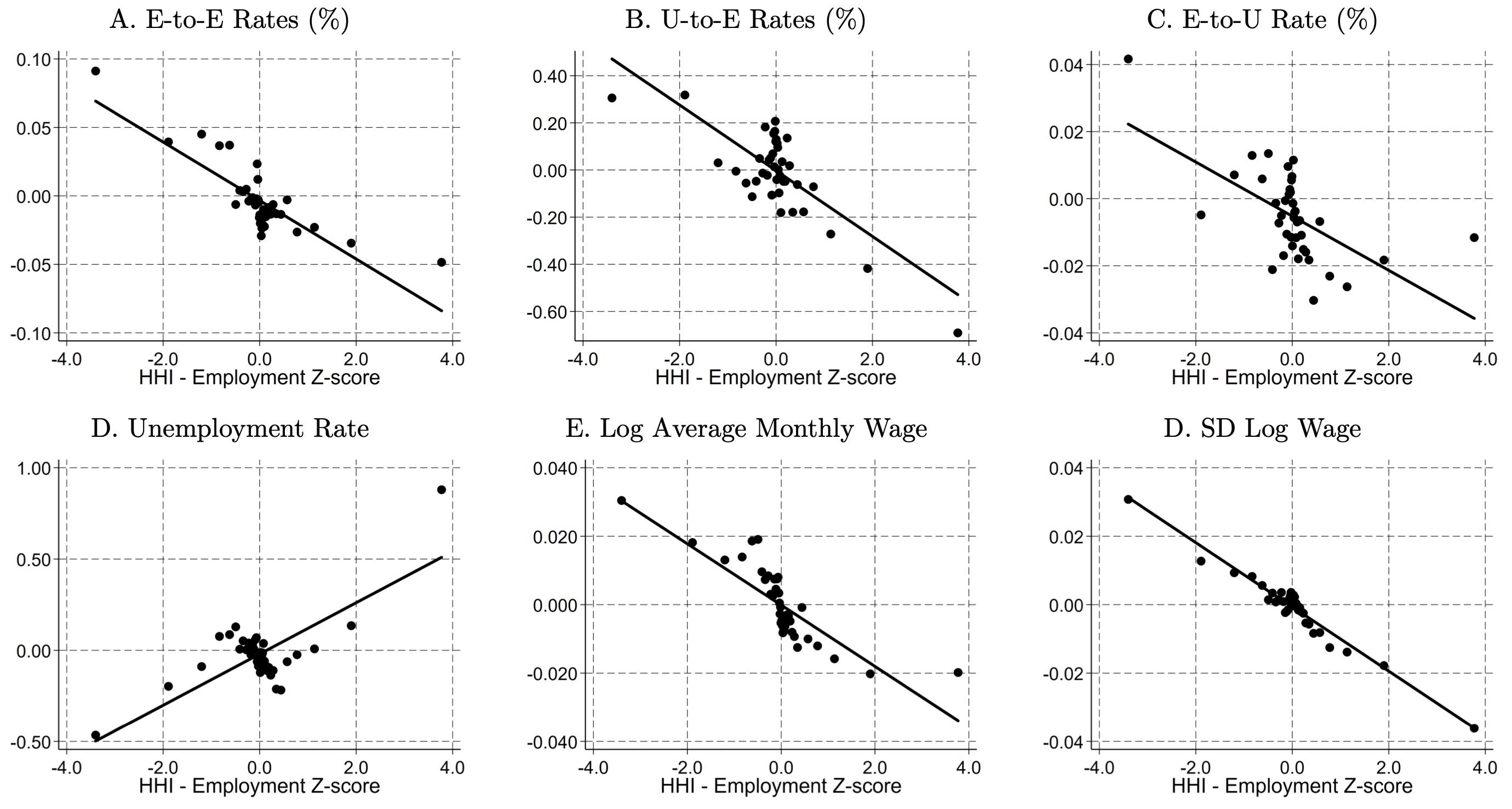Everyone knows the objective of the game Monopoly: buy all the real estate, utilities and railroads to become the dominant seller of those services and then extract all the money from your competitors. If there were to exist a game called Monopsony, the objective would be to become the dominant employer in town and then to maximise profits by using your dominant position in the local labour market to pay less-than-competitive wages to your employees (where else could the workers go?) (Naidu et al. 2018).
While there is much research exploring the many facets of monopoly, the causes and consequences of monopsony are less well understood. Standard theories of monopsony assume that an infinite(!) number of competitors exist in every labour market (e.g. Burdett and Mortensen 1998, Card et al. 2018). These models rule out market configurations with finite numbers of employers in a market. But data show that exactly how many employers are in a market and how large they are within the market are strongly correlated with wages and employment prospects.
Using unique data from Norway, Figure 1 shows how job flows, wages, and inequality vary with the local employment Herfindahl (HHI), a common measure of market concentration. More concentrated markets with higher HHIs exhibit:
- lower job flow rates from employer-to-employer (E-to-E), from unemployment to employment (U-to-E), and from employment to unemployment (E-to-U)
- slightly higher unemployment rates
- lower monthly wages
- much less inequality measured by the standard deviation (SD) of monthly wages.
Figure 1 Job flows, wages, and market concentration
Notes: For each market (where a market is defined, as in Section 2, as a cluster of occupations within a commuting zone) we compute the employment Herfindahl (HHI). E-to-E: employer-to-employer, U-to-E: from unemployment to employment, E-to-U: from employment to unemployment. SD: standard deviation (SD) of monthly wages.
Our recent work (Berger et al. 2023) is motivated by these empirical findings and the lack of a suitable model to which to apply our findings. We explicitly model a finite number of firms in each market while also incorporating a state-of-the-art wage-setting process. We use our framework to measure the sources of monopsony, using unique administrative data from Norway that includes information on where firms are located, how much they pay, and what occupations they hire.
The goal of our paper is to provide a better understanding of the origins of monopsony so that we can design policies more effectively. Because of monopsony, we find that workers are paid a wage that is 21% less than what they produce (i.e. 21% less than the competitive wage). We refer to this 21% wage gap as a wage markdown.
Roughly half of the wage markdown is driven by the fact that most employed workers simply do not search that often for new jobs (i.e. searching for jobs is a slow and time-consuming process). Another third of the wage markdown comes from workers liking their job over and above the wage it pays (i.e. a worker might take a pay cut to work at a firm with a short commute or pass on a more lucrative wage offer if they have a boss that they get along with).
The remaining wage markdown is explained by non-competitive wage bargaining. When an employed worker receives a job offer, their current employer does not pay a penny more than is necessary to retain the worker. If the worker chooses to leave, the poaching firm behaves strategically as well – they also do not want to pay a penny more than necessary to poach the worker. This negotiating process is stacked against the worker and reflects the fact that there are only two firms at the bargaining table.
Based on our findings, we came away with three recommendations for future research and policy:
- The slow and time-consuming nature of job search is a significant source of wage markdowns but is perhaps the most difficult to address with policy. We believe these ‘search frictions’ in the labour market are immutable to policy. This view is also held by other economic and legal scholars (e.g. Naidu and Posner 2022).
- Models in which non-pay characteristics of jobs generate wage markdowns and monopsony are as old as the literature itself (Robinson 1933). In the simplest of those frameworks, minimum wages can restore full efficiency of the economy and eliminate monopsony power. However, in richer settings in which larger, more productive firms have the most market power, minimum wages are quite ineffective at eliminating monopsony power (Berger et al. 2022).
- Our findings suggest that future work on non-competes and bargaining protocols may be a fruitful avenue for policy aimed at mitigating monopsony (e.g. Morrison and Molla 2023). Non-competes are binding agreements between workers and past employers limiting what they can do and who they can work for after they leave (Stewart 2023). Non-competes limit future worker job flows and clearly affect worker-firm bargaining. Recent work by Shi (forthcoming) shows that a near ban on non-competes is optimal, and we believe more research is needed on this topic.
- Lastly, in ongoing work, we assess how antitrust policy affects wage setting (Berger and Hasenzagl et al. 2023). While many papers study product market concentration and consumer welfare, there is much less work on the way mergers affect worker welfare.
We hope that future researchers and policymakers will use our model and results to better design labour market policies.
References
Berger, D W, K F Herkenhoff, and S Mongey (2022), “Minimum wages, efficiency and welfare”, NBER Working Paper w29662.
Berger, D W, K F Herkenhoff, A R Kostøl, and S Mongey (2023), “An anatomy of monopsony: Search frictions, amenities and bargaining in concentrated markets”, NBER Working Paper w31149.
Berger, D W, T Hasenzagl, K F Herkenhoff, S Mongey, and E A Posner (2023), “Merger guidelines for the labor market”, NBER Working Paper w31147
Burdett, K, and D T Mortensen (1998), “Wage differentials, employer size, and unemployment”, International Economic Review 39(2): 257–73.
Card, D, A R Cardoso, J Heining, and P Kline (2018), “Firms and labor market inequality: Evidence and some theory”, Journal of Labor Economics 36(S1): S13–S70.
Morrison, S, and R Molla (2023), “What banning noncompetes could mean for the US workforce”, Vox.com, 7 February.
Naidu, S, and E A Posner (2022), “Labor monopsony and the limits of the law”, Journal of Human Resources 57(S): S284–S323.
Naidu, S, E Posner, and G Weyl (2018), “More and more companies have monopoly power over workers’ wages. That’s killing the economy”, Vox.com, 6 April.
Robinson, J (1933), The economics of imperfect competition, Palgrave Macmillan.
Shi, L (2023), “Optimal regulation of noncompete contracts”, Econometrica, forthcoming.
Stewart, E (2023), “How your boss keeps control even when they’re no longer your boss”, Vox.com, 18 May.








